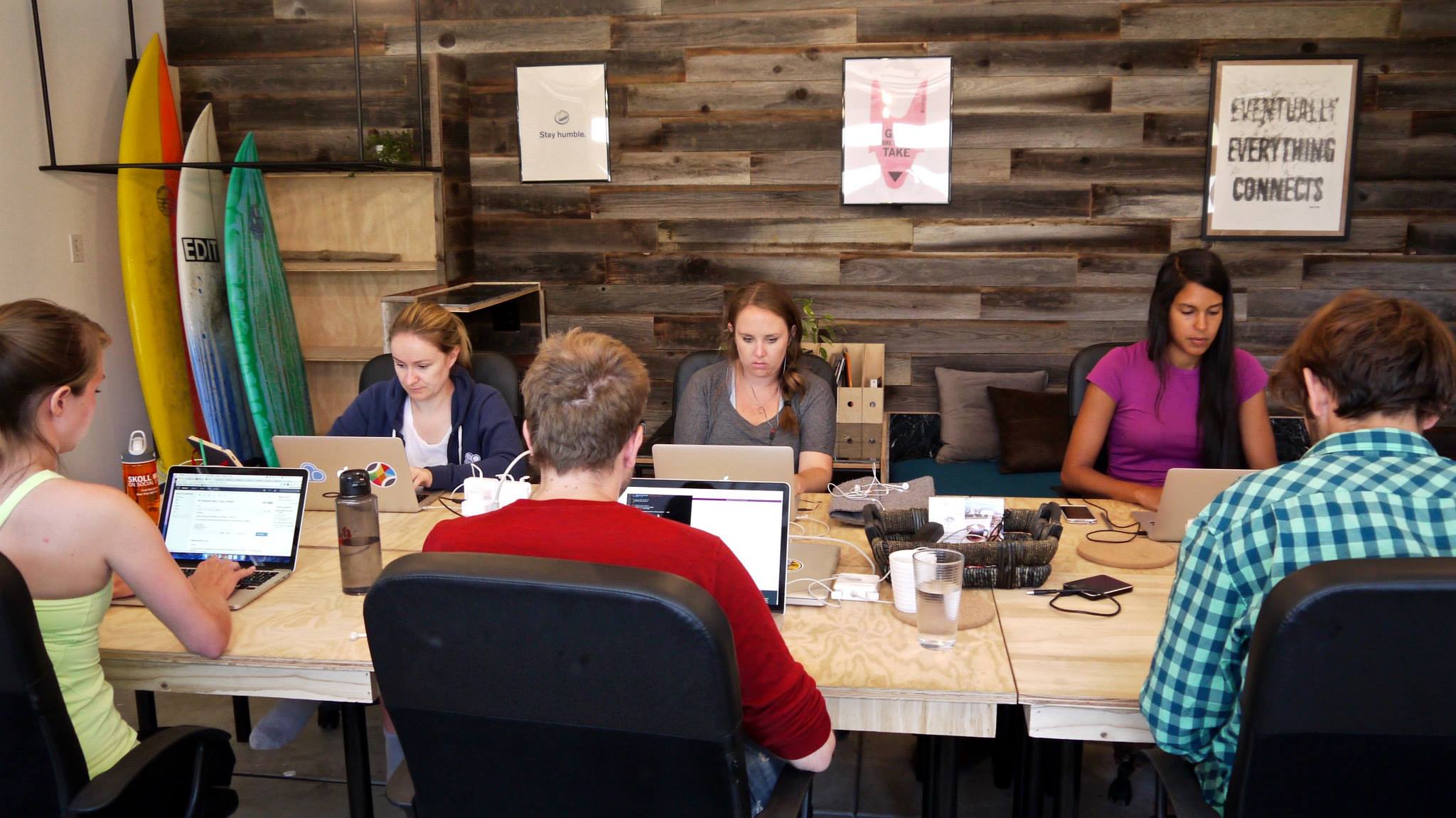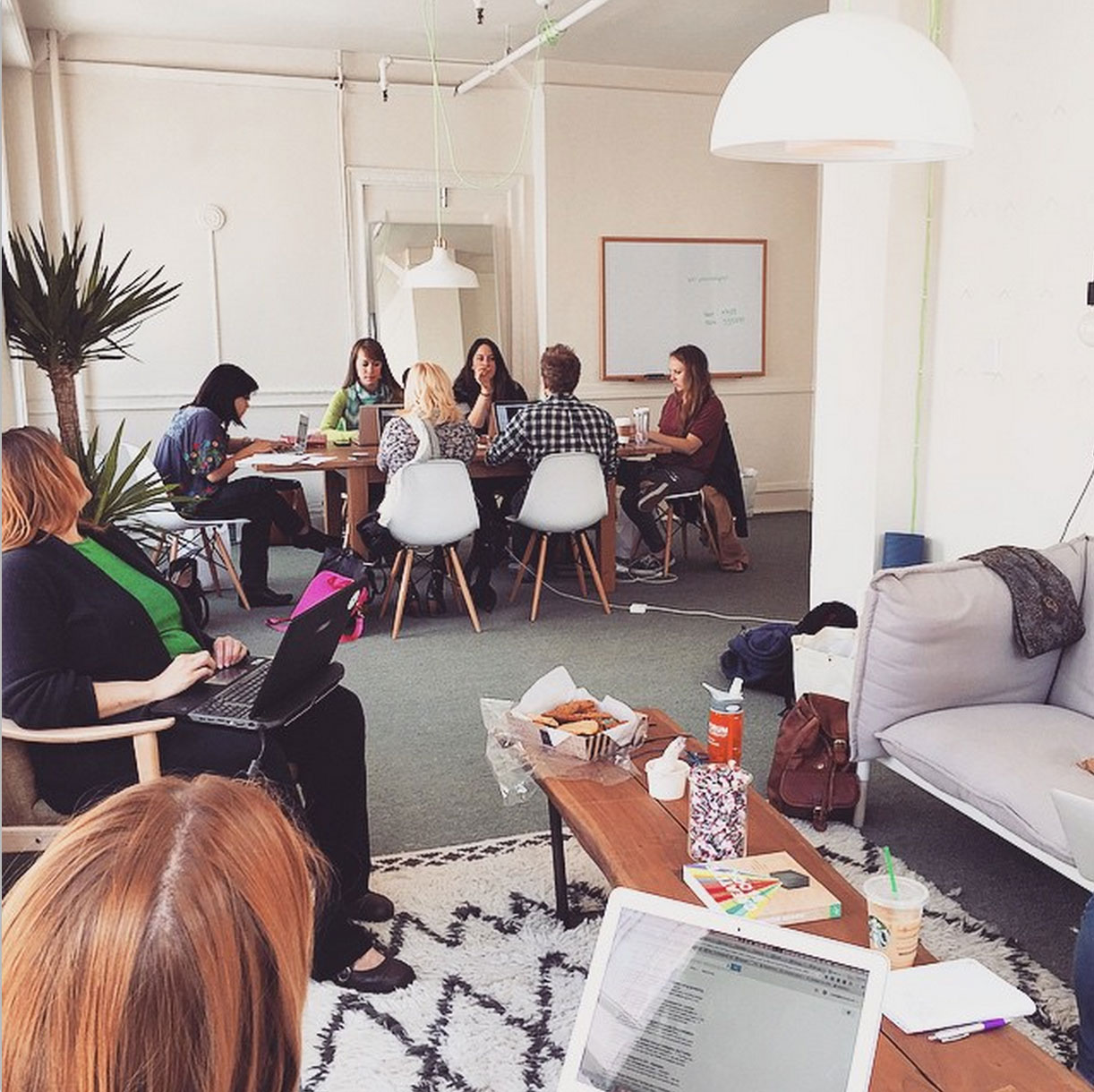In January 2014, Kate Kendall launched CloudPeeps, a marketplace for freelance community, content and marketing professionals. Just under two years later, CloudPeeps now has over 100 customers and has received over 2,000 freelancer applications. She also runs an email newsetter, The Fetch, which serves work-related content and event listings to over 30,000 subscribers.
Both companies are fully distributed and Kendall has become something of a remote work evangelist on Twitter. Below she shares the story behind The Fetch and CloudPeeps, what drew her to remote work, and what it's like to build and manage a pair of successful distributed companies.
Tell me about CloudPeeps and The Fetch and what do you do there.
So, I had the ideas for The Fetch and CloudPeeps around the same time in 2011 when I was living in Melbourne, Australia. The Fetch was a way to curate all the great professional-geared events happening in one guide (a weekly email digest) and CloudPeeps originally started as a service that connected startups and small businesses with remote community managers.
After bootstrapping The Fetch for a few years full-time and struggling to find and manage the right freelancers to help me grow my business, I came back to CloudPeeps as a way to solve this problem. In January 2014, it launched as a talent marketplace that matches businesses with top freelance marketing, content and community pros.
My role as an early-stage startup CEO varies greatly – I work across everything from product to operations, sales to content, fundraising to community building.
Your Twitter bio describes you as a lover of "remote work culture." What initially drew you to remote work?
When I was finishing up my college degree, I always had this approaching dread of working 9-to-5 in an office. When I did start my first full-time job, I'd spend 45 minutes commuting one way to then sit in a windowless, open plan, grey office. I found it all very inefficient, unproductive and exhausting. I always felt like I could achieve more in a flexible environment.
At first, I wanted the freedom just to work a bit later – or even go to the doctor or post mail during business hours. Then I started seeking freedom to travel and pursue personal projects. All this led to me selling a lot of belongings and becoming a digital nomad for a few years. Now, I love that remote work is mainstreaming with numerous companies working this way.
Your companies operate with a fully distributed team. How many people are there total and how spread out are they?
Right now, I'm working with eight people remotely – we have the majority of the team in San Francisco, then there are folks in Brooklyn, Orange County, Berlin, Toronto and Rome!
How do you keep everyone feeling connected?
Slack has honestly changed the nature of work forever. Even when I visit a large tech company's office, I notice everyone is communicating via IM and the emphasis is less on in-person conversations. To keep connected, we host an all-team weekly standup via Google Hangouts on Mondays, then I do direct synchs with different teams throughout the week. We also have an active and well-organized Slack channel (make the most of integrations), and use Asana, Trello and Github to monitor projects. Another thing we do is biannual team retreats where we all get-together for some face-to-face time. We're still a growing startup, so we don't go to far-off places like say, the Buffer crew does! We've been to Lake Tahoe and Santa Cruz so far.

What are the biggest challenges you face working remotely and how do you overcome them?
Some of the challenges of remote work can also be seen as benefits. For instance, I think it's really easy to tell who's performing and who isn't in a remote team – as well as who really gets what you're trying to achieve in your business, and who has been a bit distracted or less focused. So much of remote work is about productivity and communication – you'd think it'd be easy to hide working remotely but it isn't. Setting clear goals, milestones, deadlines and a task owner along with lots of planning is key. We do monthly one-on-one feedback sessions to make sure we stay on the same page.
I'd spend 45 minutes commuting one way to then sit in a windowless, open plan, grey office. I found it all very inefficient, unproductive and exhausting.
What is the biggest benefit that working remotely has afforded your company?
The biggest benefit is that it's attracted the right kind of people to CloudPeeps. We have a diligent, humble, productive and kind group of folks on the team. We do a lot with a little. We don't have the usual politics that you sometimes hear about in traditional offices: people masking other people's ideas as their own, never-ending meetings, questionable interactions to minorities, not leaving the office until after 10pm, crazy managers and so forth.
Another benefit is that we've been able to lessen our burn rate as we're not spending thousands and thousands of dollars on an office each month. Some tech companies are spending hundreds of thousands of dollars on offices each year, and I like that we can put more back into our business or salaries.
Do you think you lose anything by working remotely?
I think you lose a bit of the ability to set and control a team's pace working remotely. There's going to be some times when you need to work faster and hustler harder to meet goals, and it's easy to do that in person when you're side by side. That said, I think remote work creates a more consistent pace – it's like running a marathon or being an athlete – and there's less long-term burnout and higher retention.
What do you think is the most important thing a distributed team can do to ensure successful collaboration between team members?
Set the collaboration around an action item and goal. Often we think of collaboration as communication so the focus is on the communication rather than the action. We used to spend a lot of time communicating on Slack, which in effect is the same problem of spending too much time on emails. We switched our communication to be around Asana for non-tech tasks and Github for tech so that collaboration is always focused around a goal. We then have an #ideas channel in Slack and do some brainstorming over a Hangout to collaborate on items outside of the day-to-day.
So much of remote work is about productivity and communication – you'd think it'd be easy to hide working remotely but it isn't.
It can be difficult to build a cohesive culture across geography. Is there anything special you do to bring the team closer together (either physically or virtually) and nurture a unique dynamic?
Our team retreats have been great for bringing people together face-to-face. We've also just launched the Freelance Friday community as a monthly coworking meetup for creatives, entrepreneurs and independents, which allows our team to connect with their local community too. We also sponsor coworking memberships, so team members can get some people-time in when desired.

Describe your personal work environment.
I work from home in my sunny apartment in San Francisco. It's right near Chrissy Field and the Presidio, which was important for me as I wanted somewhere close to nature after living in New York for two years. I have one of those white IKEA Melltorp four-person dinning tables that I use as a desk. My external display and mouse pad is also white so I tend to opt for minimal and clutter-less environments. When I want to mix things up a bit, I work from my couch. This Byllan laptop desk was probably the best $15 I've spent! I'm trying to bring more plants into my environment. Another thing to note is that I rarely listen to music. I focus better and get more stuff done in silence! I use Leuchtturm1917 notebooks to jot down notes and clear my mind.
How do you personally manage work/life balance? Do you think that balance is harder to find without an office to go to every day?
I think my remote work experience and work/life balance would be different if I wasn't a founder or CEO. It's hard to have true balance regardless of having an office or not. You're constantly on, thinking about company growth or managing projects and people – if you've raised a round of funding, that also adds additional time pressure, responsibilities and expectations.
When I was working solo on my first company, The Fetch, I actually found balance harder though and would work 100-hour weeks. With CloudPeeps, I tend to take weekends off and encourage the rest of the team to not contact others (use a Gmail plug-in Boomerang or Streak to schedule emails for the week if you want to catch up on the weekend). I also do lots of exercise, including indoor soccer, barre, yoga, running, hikes and get plenty of sleep. ClassPass is great for accessing numerous gyms and studios on-demand.
What do you do to make sure you're operating at peak efficiency?
I track my time in RescueTime and look back on the weekly summary each Sunday to see where I spent my time and focus. I wish it would monitor my iPhone and calendar so I could get more of a complete understanding. Sleep is also very important to me – I tend to make sure I'm asleep by 12am now (coming from a 2-3am background) so I can get a good eight hours. Also, eating well. I'm pescatarian, don't drink coffee and alcohol rarely.
List some of the tools you couldn't live without as a remote company.
We use an insane amount of cloud services as a remote company: Slack and Google Apps for everything, Asana and Trello for project management, Github, Heroku, AWS and Bugsnag for development, Help Scout for happiness and our knowledge base, Xero for accounting, Buffer for social media posting and analytics, Campaign Monitor and SendGrid for email, Justworks for payroll, Stripe and Paypal for payments, 1Password for password collaboration, Baremetrics for SaaS analytics, HelloSign for legal signatures, Twitter Bootstrap for easy prototyping, and so on.
What advice would you give to a company heading down the remote working path?
I know a lot of larger tech companies who have a combination of both now but I'd say pick one or the other. Especially if you're early-stage. Around six months in we were trying to do both at CloudPeeps and it wasn't working out – our team culture felt split and people were confused. When we made the decision to embrace being fully remote, things fell into flow faster.